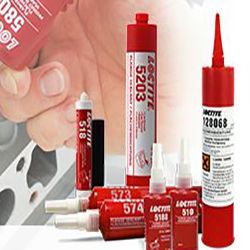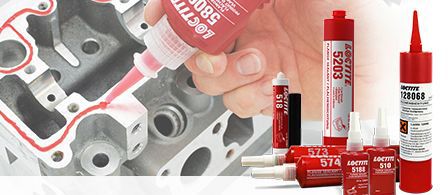
LOCTITE Gasket Seals - alternatives to conventional pressure gaskets to prevent liquid and gas leakage between flange surfaces.

Our products
LOCTITE gasket sealants are a reliable alternative to traditional pressure gaskets to prevent fluid and gas leakage between flange surfaces.
In addition, Loctite anaerobic Gasket sealants act as both an adhesive and a sealant between two flanges. The liquid sealant completely fills the gap between the flange surfaces, preventing gaseous or liquid substances from leaking into composite machine parts or pipe joints. At the same time, adhesion to flange surfaces increases the strength of the part.
Applied in liquid form, LOCTITE flange sealants fill imperfections on metal flange surfaces, allowing for sealing of defective areas. These sealants cure in metal structures and in the absence of air to form a durable seal with maximum surface contact between components. Loctite flange sealants also remove corrosion and ensure that, with LOCTITE flange sealants, the rapid low-pressure seal applied to the part after full cure will not shrink, break, or loosen and resist gasket displacement better than conventional gaskets.
All products
→ LOCTITE 510
→ LOCTITE SI 5970
→ LOCTITE 5188
→ LOCTITE SI 5699
→ LOCTITE 574
Advantages of LOCTITE gasket sealants compared to conventional pre-cut pressure seals
→ Reduces stock by using a product for all designs
→ Fills the voids and imperfections on the entire surface due to its fluidity
→ Eliminates gasket loosening and leakage
→ Prevents the gasket from coming off and slipping
→ Provides fast sealing
→ Excellent chemical resistance
→ Provides high-pressure sealing when fully cured
LOCTITE gasket sealants offer significantly higher performance and numerous benefits compared to conventional sealing systems such as pre-cut gaskets.
The major causes of failure and leakage of pressure seals are as follows:
Surface contact: Pressure seals do not provide full contact between the gasket and flange surfaces. So small leaks can always occur (dripping rate)
Pressure adjustment: Pressure gaskets loosen under dynamic loads and their thickness decreases due to the loss of bolt tension in the flange connection part, which causes leakage.
Displacement: Gaskets can get stuck between flanges.
Bolt hole deformation: High voltage is transferred to the gasket material under the bolt head, which causes the gasket to break, tear, rupture or dislodge.